#The Dispossession of Women
Explore tagged Tumblr posts
Text
Pat Brewer – Kadının Mülksüzleştirilmesi (2025)
Pat Brewer’ın ‘Kadının Mülksüzleştirilmesi’ (‘The Dispossession of Women’) adlı kitabı, kadınların tarihsel ve güncel olarak mülksüzleştirilmesini, yani ekonomik, sosyal ve siyasi güçten yoksun bırakılmasını inceleyen bir eserdir. Brewer, bu kitabında, kadınların mülksüzleştirilmesinin sadece ekonomik bir sorun olmadığını, aynı zamanda toplumsal cinsiyet eşitsizliğinin temel bir boyutu olduğunu…

View On WordPress
#2025#Kadınların Ezilmişliğinin Kökenlerine İlişkin Yeni Delil ve Bulgular Üzerine Marksist Bir İnceleme#Kadının Mülksüzleştirilmesi#Meral Üst#Pat Brewer#Sümer Yayıncılık#The Dispossession of Women
0 notes
Text
The thing about the broadly left-of-center in the United States that I find striking in this moment is the conceit that they did literally everything they could and it didn't work, and this just proves the United States is worse than they ever imagined
I suspect this is one of the main problems with their strategy. They cannot pretend not to hate the United States long enough to make it stick. Every time they try, it is immediately recognized for the lie that it is, and then when their lie fails to catch, the mask then drops immediately, and they revert back to their miserable and bitter selves
#and look#there is no leftism writ large without the fundamental denial of reality#at its root leftism is hatred of existence itself#because it cannot tolerate imperfection#and the world as we have it is imperfect#they keep building these castles in the air#this mythical world where the proletariat--however defined--finally rises up#if only the poor would unite#if only the dispossessed#the colonized#the nonwhite#the women#whoever it is#or whatever combination#it's just not a reflection of reality
34 notes
·
View notes
Text

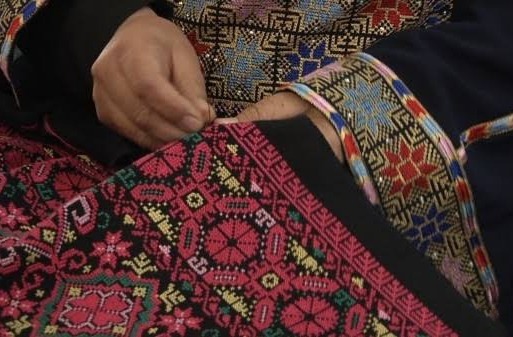

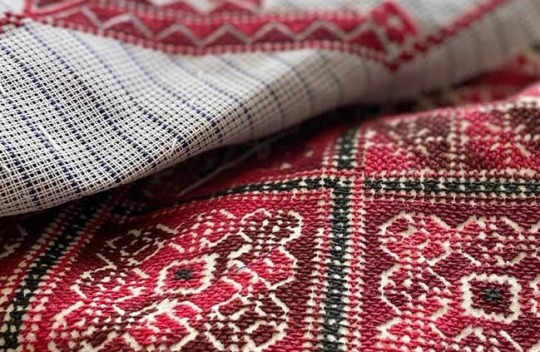
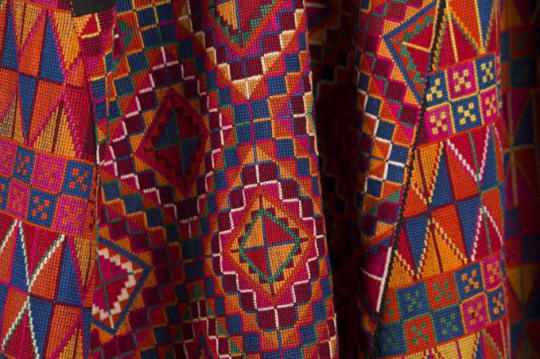

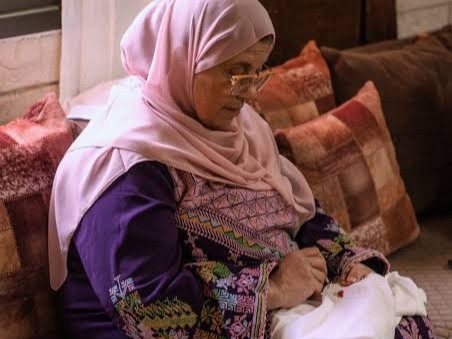

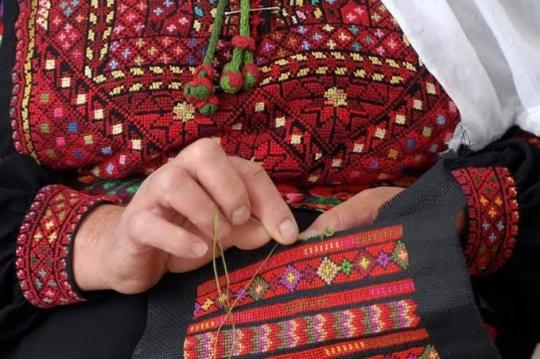
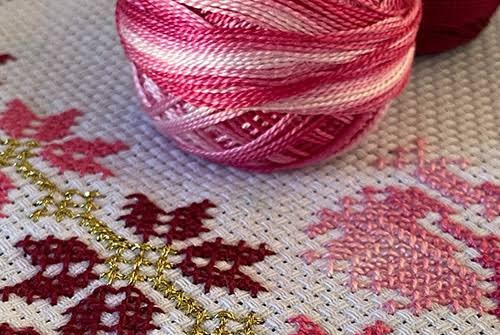
Tatreez (Arabic: تطريز) is a type of traditional Palestinian embroidery. Tatreez uses traditional cross-stitch embroidery and is practiced largely among women. The craft was originally practiced in rural areas of Palestine, but is now common across the Palestinian diaspora. Historically, each village in Palestine had their own tatreez patterns. The landscape was a major source of inspiration for the patterns and motifs, which speaks to the variation in style that was common to see among all of the different tatreez expressions that were particular to each Palestinian village.
After the violent displacement and dispossession of Palestinians in 1948, people were living together in refugee camps. The different styles of tatreez became less distinct and have continued to evolve with the diaspora. Following 1948, tatreez evolved to reflect the experiences of Palestinians. Palestinian women began to incorporate the Palestinian flag and its colors into their tatreez as a means of resistance to the occupation of Palestine. Consequently, tatreez became an expression of the identity, heritage and resistance of Palestinian women and their dedication to preserve their ancient culture.
1 / 2 / 3 / 4 / 5 / 6 / 7 / 8 / 9 / 10 / 11 | textile series
#textiles#ots#tatreez#palestine#palestinian art#palestinian culture#free palestine#embroidery#textile art#middle east#levant#levantine#fashion
14K notes
·
View notes
Text
Conversation between me, and another high educated Jewish women whose opinions I respect
Her: What's missing here are the facts. If we stuck to the facts there wouldn't be so much intensity surrounding this issue. Me: But you and I are both highly educated Jewish women, and we can't even agree on the facts regarding the history of Palestine as a place name, ethnic identifier, and nation. If we can't even agree on those facts, how on earth can facts help anyone move forward?
There's the question. Not just for Jews, but for everyone involved in, or concerned with this conflict. How do we move forward if multiple sides of the room dispute the veracity of such basic statements as:
-Jews are a globally oppressed minority ethnic group, the hatred of which is deeply embedded in Western thought and rhetoric.
-The Naqba was a period of ethnic cleansing in which the government and military of the new State of Israel expelled Palestinian Arabs from their homes and property; a dispossession and a series of events which continue to traumatize and negatively impact the lives and livelihoods of Palestinians.
-The Holocaust was a traumatic event in the history of the Jewish people, the legacy of which is embedded in the psyches, world views, and collective trauma of the Jewish people, and invariably impacts how this group views global issues.
-Palestinian Arabs had a full developed sense of identity and statehood before the British Empire fucked off, and made their discomfort with increasing Jewish emigration clear to the British before the outbreak of the Second World War.
-Jews had nowhere to go before, during, or really, after the Holocaust; and the governments of many Arab States ethnically cleaned their own ancient Jewish communities in retribution for the creation of the State of Israel.
-The State of Israel does not exist because the Holocaust happened, or as an "apology" for said event.
THIS POST COMPRISES A SERIES OF RHETORICAL QUESTIONS MEANT TO MAKE US APPRECIATE THE DEPTHS OF THE DISCURSIVE PROBLEMS HERE; NOT A POST FOR "DISCOURSE" AND HATEFUL, AGGRESSIVE SHIT.
If you feel you have to do that, copy & paste into your own separate post.
1K notes
·
View notes
Text
[Image Description: There are nine images being described. The images describe different crisis' the Congo is facing at the hands of three trillion-dollar corporations (Apple, Alphabet (the parent company of Google), Microsoft) and two billion-dollar corporation (Tesla and Dell Technologies). The resulting ID is long, and thus has been placed behind the 'Keep reading' link.
The first image contains two pictures, one at the top of the image and the other at the bottom, with black text on a white background in the middle. The top picture is of the Congo Rainforest and Basin, a vibrant green rainforest with a winding brown river cutting through the middle of the picture from top to bottom. The bottom picture is of a mining expedition in the Congo. A large Hydraulic Mining Shovel is in the foreground of the picture and a comparatively tiny human stands beside it on the right side of the picture. The background of the picture is brown, dug-up dirt and the wall of dirt behind the Hydraulic Mining Shovel and human extends past the top of the picture. They are far below surface level. The text in the middle is titled "Congo v. Apple, Tesla, Google, Microsoft, and Dell. Congo involves each and every one of us." and contains a quote from Friends of the Congo which reads: "The main request from local Congolese leaders is for others around the globe to build solidarity to help amplify their voices and build relationships with other justice advocates (climate, Indigenous, youth, human rights, artists and musicians)."
The second image uses the same format as the prior image, with two pictures and a section of text in the middle. The top picture is of the outside of an Apple store, with the Apple logo shown clearly in the centre of the image. The bottom picture is of underage children mining cobalt. There is a young boy in the foreground, wearing only shorts and covered in dust, crouched and holding a small hammer. There are four other people in the background of indeterminate age. The text in the middle is titled "Child Labour" and reads: Cobalt exploitation in Congo starkly reflects the neocolonial underpinnings of our global economic system, as multinational corporations, driven by profits and greed, exploit vulnerable communities, forcing children into hazardous mining labour, perpetuating an unjust cycle of oppression (Amnesty International, 2016).
The third image uses the same format as the prior image, with two pictures and a section of text in the middle. The top picture is of the outside of a Google store, with the logo and brand name clearly shown. The bottom picture is of a young woman in a field of dirt mounds. She is in the foreground of the picture, and is bent over and holding a cardboard box with fabric lining the bottom in one of her hands while the other holds a small child to her chest. There is a young man present in the background, on the right side of the picture. The text in the middle is titled "Women's Rights" and reads: Within the cobalt mining landscape, women bear the brunt of an inherently unequal system, where their rights are trampled upon amidst a backdrop of corporate greed and capitalist structure that systemically marginalizes and subjects them to gender-based violence (Human Rights Watch, 2019).
The fourth image uses the same format as the prior image, with two pictures and a section of text in the middle. The top picture is of the outside of a Tesla store, with the logo clearly shown in the middle of the picture. The bottom picture is of a large group of displaced Congolese people. They are moving in three lines and are transporting essential items such as bedding. The text in the middle is titled "Genocide and War" and reads: The intertwining of cobalt extraction with conflict financing exposes the dark underbelly of a capitalist world order, where profit motives often fuel violence and geopolitical instability, revealing the neocolonial legacy that continues to haunt the affected regions (Global Witness, 2016).
The fifth image uses the same format as the prior image, with two pictures and a section of text in the middle. The top image is of the inside of a Dell Technologies store, with the Dell Technologies logo and brand name shown clearly alongside 23 display computers. The bottom picture is of 24 Congolese people standing in the foreground of the image. Behind them are numerous white tents that extend past the top of the image. The text in the middle is titled "Land Dispossession" and reads: Cobalt mining, echoing historical patterns of colonial resource exploitation, strips local communities of their land rights, casting a shadow on the purported ideals of self-determination while reinforcing a neocolonial dynamic that perpetuates land dispossession (International Labour Organization, 2020).
The sixth image uses the same format as the prior image, with two pictures and a section of text in the middle. The top image is of the outside of a Microsoft store, with the Microsoft logo and brand name clearly shown on the left and right of the image. The second image is of a dirt valley, which is likely an old cobalt mine, with numerous people in the middle. There is no vegetation to be seen and countless sandbags piled on top of each other to decrease land degradation. The text in the middle is titled "Environmental Degradation" and reads: The environmental degradation resulting from cobalt exploitation serves as a poignant metaphor for the ecological costs paid by marginalized nations to fuel the insatiable machinery of capitalist consumption, underscoring the urgent need for a more sustainable and just economic paradigm (United Nations Environment Programme, 2017).
The seventh image contains five graphs and is aptly titled "Big Tech Profits Off Atrocities". Each graph shows the revenue of the five companies (In order of graph appearance: Google, Microsoft, Dell, Tesla, and Apple). The first graph is titled "Revenue of Google from 1st quarter 2008 to 3rd quarter 2023 (in million U.S. dollars)". The most recent data point plotted is from the 1st quarter of 2023, which rests just under 80,000 million U.S. dollars. The second graph is titled "Microsoft's net income from 2002 to 2023 (in billion U.S. dollars)". The most recent data point plotted is from 2023, which rests at 72.36 billion U.S. dollars. The third graph is titled "Dell Technologies net revenue worldwide from 1996 to 2023 (in billion U.S. dollars)". The most recent data point plotted is from 2022, which rests at just above 100 billion U.S. dollars. The fourth graph is titled "Tesla's revenue from FY 2008 to FY 2022 (in million U.S. dollars)". The most recent data point plotted is from 2022, which rests at 81,462 million U.S. dollars. The fifth graph is titled "Apple's net income in the company's fiscal years from 2005 to 2023 (in billion U.S. dollars)". The most recent data point plotted is from 2023, which rests at 96.99 billion U.S. dollars.
The eight image contains three paragraphs of white text on a black background, with lines coloured green, red, and blue separating them. The first paragraph reads: We're not buying McDonalds in 2024, or Starbucks or Puma. 🇵🇸 We're not replacing our phones because we feel like it. We're not replacing our laptops because we don't know what else to ask for for Xmas. The second paragraph reads: We're not buying five devices that are identical in every way but size. 🇨🇩 We're not being friends with people who deny that what is happening in Palestine, Sudan or Congo is horrific and has to stop. The third paragraph reads: We're not explaining empathy to Zionists or racists in 2024.
The ninth image contains three rectangular sections: the top section is coloured black, the middle section is coloured green, and the bottom section is coloured red. There is text in each section. The top section's text is written in white. It reads: The UAE are funding crimes against humanity in Sudan, Palestine, Yemen, and Congo. The words "crimes against humanity" are written in red. The middle section's text is written in black and all capitals. It reads: Join us to protest the force that funds these atrocities. The bottom section's text is written in white. It reads: Sunday 14th January 12 noon. London.
/.End ID]
Learn about Congo 🇨🇩 We cannot , after finding out so shamefully late about the genocide, continue as per. We have to change our choices and make the effort to be as ethical as we can and talk about this!
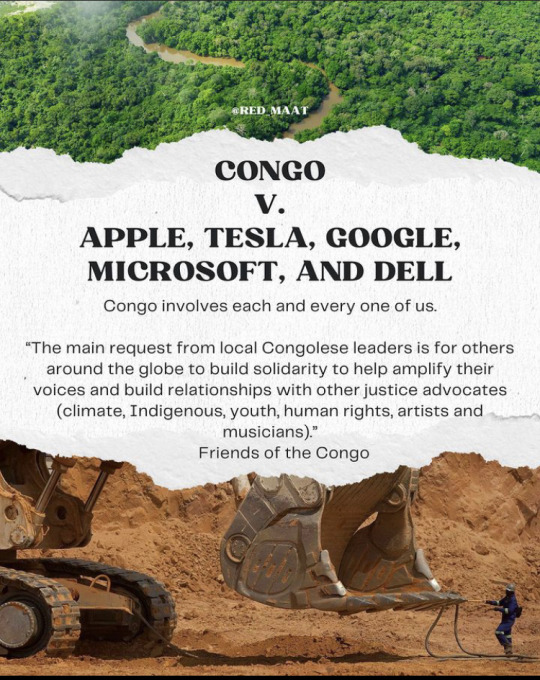
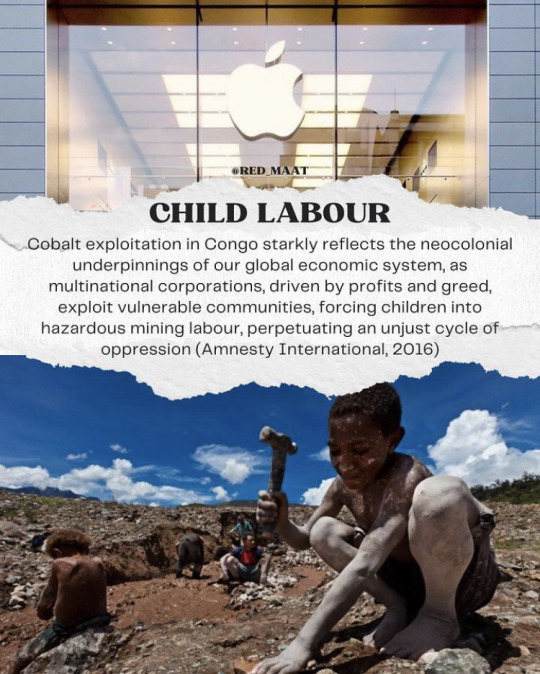

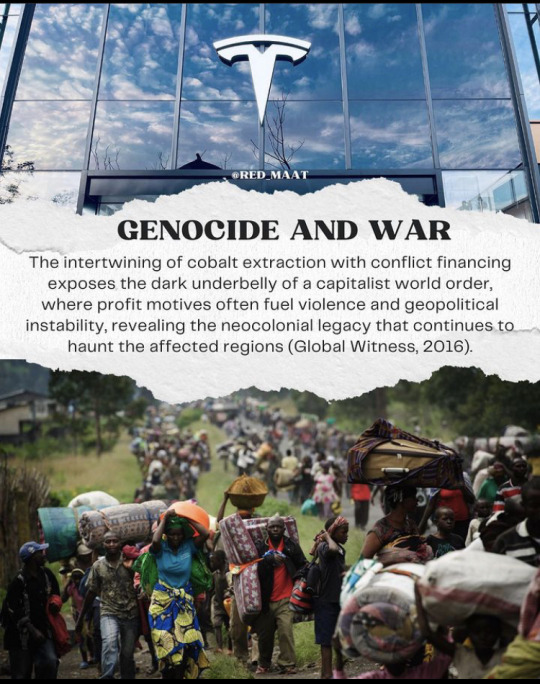
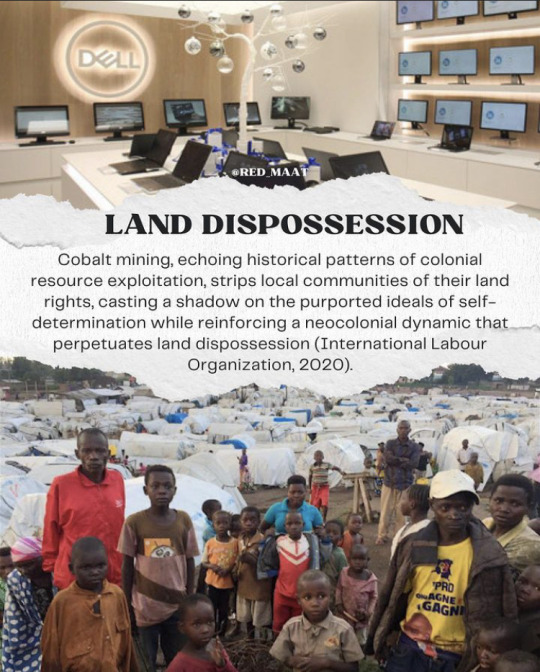


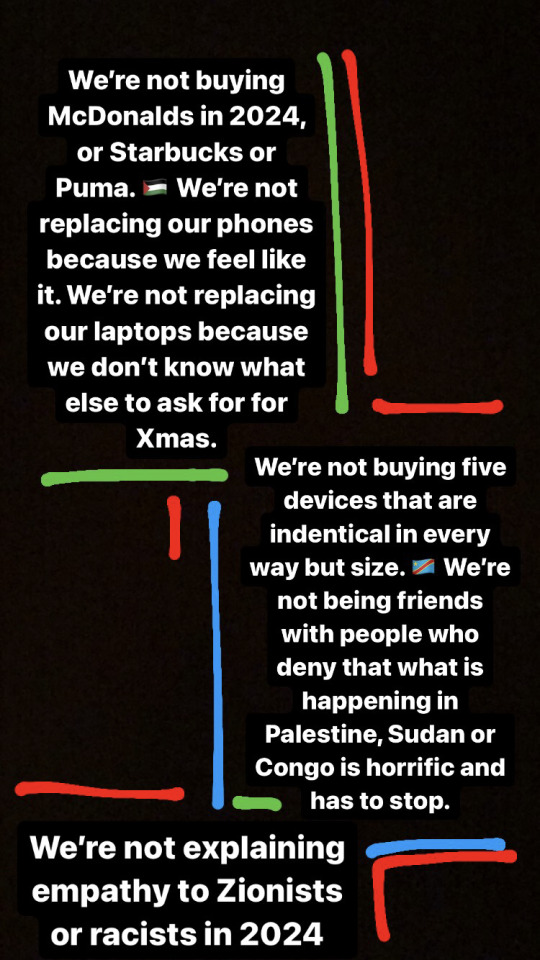

#image description#accessability#long post#congo#the republic of congo#trillion dollar companies#billion dollar companies#apple#tesla#google#microsoft#dell#dell technologies#crimes against humanity#child labour#women's rights#genocide#war#land dispossession#environmental degradation
2K notes
·
View notes
Text
A lot of people here take an incredibly mechanistic, economist approach to their understanding of historical materialism. To a certain degree this is promising, since it is a position characteristic of new marxists, and implies good growth and development; but more straightforwardly it is an error.
Yes, in the base-superstructure relationship, the base is the dominant and deciding factor, however the superstructure does exert a real and material force on society - and the flat denial of the role of the superstructure in favour of a purely economic understanding of society is plainly incomplete, and leads to gross rightist errors, by minimising the harmfulness of reactionary superstructure. Sexual violence against women in society ultimately has its basis in the material dispossession and oppression of women, but superstructural elements - 'rape culture' - are as much the proximate cause of any definite act of sexual violence in society as economics, and certainly exist as a powerful force to oppose and undermine progressive and revolutionary approaches to the liberation of women.
Marx said:
The weapon of criticism cannot, of course, replace criticism by weapons, material force must be overthrown by material force; but theory also becomes a material force as soon as it has gripped the masses.
514 notes
·
View notes
Text
KASHMIR MASTERLIST
Background
History of Kashmir from 250 BC to 1947 [to understand Kashmir's multi religious history and how we got to 1947]
Broad timeline of events from 1947 to the abrogation of Article 370 of the Indian Constitution in 2019 (BBC) [yes, BBC. hang on just this once]
Human Rights Watch report based on a visit to Indian controlled Kashmir in 1998 [has a summary, background, human rights abuses and recommendations]
Another concise summary of the issue
Sites to check out
Kashmir Action - news and readings
The Kashmiriyat - independent news site about ongoings in Kashmir
FreePressKashmir - same thing as previous
Kashmir Law and Justice Project - analysis of international law as it applies to Kashmir
Stand with Kashmir - awareness, run by diaspora Kashmiris (both Pandit and Muslim)
These two for more readings and resources on Kashmir: note that the petitions and donation links are from 2019 and also has explainers on the background (x) (x)
To read
Do You Remember Kunan Poshpora? - about women in the Kashmiri resistance movement and the 1991 mass rape of Kashmiri women in the twin villages of Kunan and Poshpora by Indian armed forces
Until My Freedom Has Come: The New Intifada in Kashmir - a compliation of writings about the lives of Kashmiris under Indian domination
Colonizing Kashmir: State Building under Indian Occupation - how Kashmir was made "integral" to the Indian state and examines state-building policies (excerpt)
Resisting Occupation in Kashmir - about the social and legal dimensions of India's occupation
On India's scapegoating of Kashmiri Pandits, both by Kashmiri Pandits (x) (x)
Of Gardens and Graves - translations of Kashmiri poems
Social media
kashiirkoor
museumofkashmir
kashmirpopart
posh_baahar
readingkashmir
standwithkashmir and their backup account standwithkashmir2 (main account is banned in India I wonder why)
kashmirlawjustice
kashmirawareness
kashmirarchive
jammugenocide (awareness about the 1947 genocide abetted by Maharaja Hari Singh and the RSS)
To watch
Jashn-e-Azadi: How We Celebrate Freedom parts 1 and 2 - a documentary about the Kashmiri freedom struggle (filmed by a Kashmiri Pandit)
Paradise Lost - BBC documentary about how India and Pakistan's dispute over the valley has affected the people
Kashmir - Valley of Tears - the exhaustion with the conflict in the post nineties
In the Shade of Fallen Chinar - art as a form of Kashmiri resistance
Human rights violations (x) (x) (x) (x) (x)
Land theft and dispossession (x) (x) (x) (x) (x) (x)
A note: I know annoying Desis are going to see this and go "Oh but Kashmir is Pakistan's because-" and "Kashmir is an integral part of India because-". I must make my stance clear: Kashmir belongs to the Kashmiris, the natives, no matter what religion they belong to. Neither Pakistan nor India get to decide the matter of Kashmiri sovereignty. The reasons given by both parties as to why Kashmir should be a part of either nation are bullshit. The United Nations itself recognises Kashmir as a disputed region, so I will not entertain dumbfuckery. I highly encourage fellow Indians especially to take the time to go through and properly understand the violence the state enacts on Kashmiris. I've also included links to learn more about Kashmiri culture because really, what do the rest of us know about it? Culturally and linguistically Kashmir differs so much from the rest of India and Pakistan (also the way Kashmiri women are fetishised... yikes). This is not just a bilateral issue between the two nations over land, this actually affects the people of Kashmir.
#this took a month of my life i'm not even kidding#ANYWAYS. hi. here you go.#kashmir#india#resources#important#history
1K notes
·
View notes
Text
Early mornings are chilly in Los Romero, a village high up in the mountains of western Guatemala. As in other predominantly Mam villages – Indigenous Maya people who have lived here since pre-Columbian times – households come quietly to life before dawn. Isabel Romero, a grandmother with long black hair, used to feel somewhat trapped in hers.
“I was afraid of speaking because I was cooped up at home. I didn’t go out,” she says, explaining that like many Mam women, her days were dedicated to the hard work of running a household with little money, and she rarely spoke with other women. “I worried a lot and had headaches.”
Residents of Los Romero live mainly from subsistence farming, growing maize, beans and squash, or grazing livestock. Almost 50% of the population is Indigenous in Guatemala, Central America’s biggest economy, but they do not share in its prosperity. Indigenous women in particular are discriminated against and dispossessed, with a life expectancy 13 years lower, and a maternal mortality rate two times higher, than the national average, according to the World Bank.
In Romero’s village and throughout the region, a community-based collective of women’s circles has been quietly improving Indigenous women’s lives, empowering them to find voices that have been suppressed through centuries of marginalisation.
It was a long process, but Romero’s headaches and fear are now a thing of the past. These days she gets out to workshops, meetings and women’s circles. She shares her knowledge of weaving traditional textiles on a backstrap loom and has a leadership role in the women’s group she co- founded: Buena Semilla (Good Seed).
The initiative emerged from Maya Mam women’s experiences, when French physician Anne Marie Chomat brought them together for interviews for her doctoral fieldwork in 2010- 2012. The simple act of gathering with others and sharing their experiences had a profound impact on the women, many of whom are still dealing with the traumatic legacy of Guatemala’s civil war.
During the 1960-1996 armed conflict between leftist guerrilla groups and the military, more than 200,000 people were killed, overwhelmingly Indigenous Maya civilians killed by the army. Another 45,000 were ‘disappeared’. A truth commission concluded that the state committed acts of genocide...
“There’s so much chronic stress and other issues that are not being addressed,” says Chomat, Buena Semilla’s international coordinator, who now lives in Canada. “So much healing happened in that space of women connecting with other women, getting out of their houses, realising: ‘I’m not alone’.”
Once Chomat’s fieldwork was finalised, several participants decided they wanted to continue meeting and with Chomat came up with the idea of women’s circles. With the help of a grant, the project got going in 2013 and now more than 300 women in two municipalities participate every week or two in circles, each comprising roughly 10 to 25 women.
Wearing traditional embroidered huipil blouses and hand-loomed skirts, the women gather, arriving on foot via the dirt roads that weave through the villages. They meet in a home or community building, or outside when they can for the connection with nature. The circle opens with a welcome and a prayer and then the group engages in breathing and movement exercises. Next up is discussion of the nahual, the day’s name and energy according to one of the interlocking ancient Mayan calendars, traditionally used for ceremonial practices. “Here in Santiago Atitlán it is only maybe 20% of people who speak about [knowledge of nahuals], so we are reviving it,” says Quiejú.
Then it’s time for the sharing circle. “More than anything, it is speaking what they have in their hearts,” says Quiejú. But every time and each circle is different, even though the leaders all work from the same guide, she says.
Sometimes circles will have a guided meditation. Sometimes they’ll have a workshop to learn weaving, or another skill that can help them earn money. Sometimes they eat together. Sometimes they cry. Often they laugh. No matter what, they generally end with a group embrace...
Only 1% of Guatemala’s national health budget is designated for mental health, and nearly all of that goes to the country’s one psychiatric hospital. Most mental health professionals are concentrated in the capital, offering psychotherapy and prescribing medications. For those in rural areas, there is little discussion of mental health or access to services.
“There is nothing for the preventative side, to work with families, to work with communities,” says Garavito. However, he emphasised that the concept of buen vivir (good living) among many Indigenous peoples in Latin America, which includes the traditional festivities, ceremonies and community of everyday village life, inherently incorporates good mental health. “Mental health is a fundamentally social concept and that has been a historical and common practice among Indigenous peoples, without them calling it that.”
...Financial constraints also pose challenges. Since 2020, Buena Semilla’s budget has been funded through crowdfunding and small grants. Staff and leaders all work part-time and many volunteer unpaid, but most circles now meet bi-weekly due to a squeeze on funds...
[Note: If you'd like to help, you can find out more and support Buena Semilla here, at their website.]
Despite the challenges, interest keeps growing. Elsa Cortez joined a circle earlier this year, motivated by her sister’s positive experience with Buena Semilla. In her mid-20s, she lives with her parents and as well as helping to run the household, she weaves belts, drawing from a basket full of spools of brightly coloured thread. She did not go out much before.
“There was a mentality that women were only supposed to be in the home or should only do certain things. That’s how we were raised,” she says. “My family was like that too.”
Thanks to Buena Semilla, those dynamics have started to shift in some families, including her own, says Cortez. Now she is exploring the idea of starting a circle specifically for girls, to help build their self-worth and self-esteem.
“It used to be difficult for me to socialise or chat, but now I am starting to socialise more easily,” says Cortez. “In the group I feel like it is psychological therapy every time we meet.”
-via Positive.News, December 8, 2023
#guatemala#latin america#indigenous#indigenous women#mental health#indigenous issues#womens empowerment#empowerment#maya#indigenous peoples#good news#hope
530 notes
·
View notes
Text
Don't let polish authorities protect Netanyahu
Quick context:
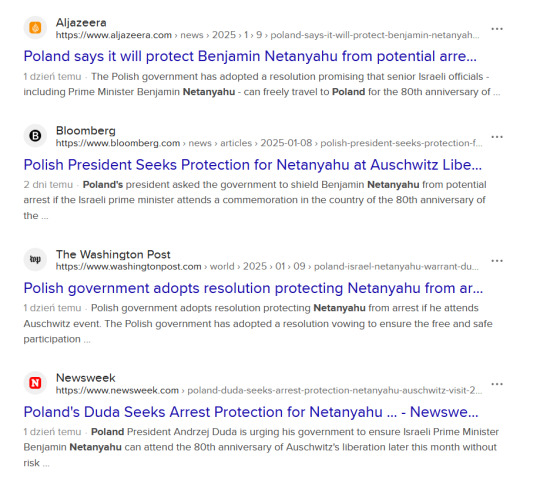
a petition you can sign to let them know you object:
Petition text in English:
Poland, December 2024
Open letter: an appeal for equal standards in the application of international law, addressed to the Prime Minister, the Council of Ministers of the Republic of Poland, the Minister of Foreign Affairs and the Minister of Justice
We, for whom the memory of the Holocaust is an ethical challenge, contained in the slogan "never again - for anyone, anywhere", we, who for a year have been watching with horror the massacre committed by Israel on Palestinian women and men in the Gaza Strip, attacks on residents of the West Bank, the bombing of civilians in Lebanon, we, who follow reports of inhumane torture in Israeli prisons, the killing of Palestinian journalists, healthcare workers and the UN, and Israel's blocking of humanitarian aid sent to Gaza, we, who for over a year have been watching with horror and anger the first-ever live coverage of genocide, the perpetrators of which publicly boast about their intentions and actions, we accept with hope the arrest warrant for Benjamin Netanyahu and Yoav Galant issued by the International Criminal Court. As human rights organizations have been emphasizing for years, bringing perpetrators of human rights violations to justice is one of the most important tools for restoring justice. The international community is responsible for ensuring that perpetrators learn that they are not above the law.
Therefore, we call on the government of Poland, a state that signed the Rome Statute establishing the International Criminal Court, to unequivocally declare that it will comply with the decision of the ICC and join the prosecution of those suspected of committing war crimes indicated by it. This is required by basic solidarity with the Palestinians. This is required by basic respect for human life, every life. This is what we expect from the Polish government, we citizens and residents of Poland, showing solidarity and compassion for those suffering.
At the same time, we want to emphasize that we consider identifying criticism of the criminal policies of the state of Israel with anti-Semitism to be absurd and immoral, as well as dangerous to the Jewish culture and tradition that many of us hold dear. We do not agree to reducing this culture and tradition to the policies of one state, repeatedly condemned by international organizations, human rights organizations and part of Israeli society. This would mean the squandering of Jewish heritage, about which Marek Edelman, the leader of the Warsaw Ghetto Uprising and a doctor in Poland after the war, used to say that being a Jew means being on the side of the beaten and wronged. We also refuse to listen to the arguments of those who try to convince us that the power occupying, displacing and dispossessing Palestinians is a weaker party than the occupied population of the West Bank and those imprisoned and besieged in Gaza for almost two decades. We call on Israel to immediately ceasefire and hold those guilty of massacres and war crimes accountable. We call on the Polish government to comply with the ICC ruling.
We assure Palestinian sisters and brothers of our solidarity and express our dreams of freedom and peace for Palestine, freedom and peace for the whole world!
#signal boost#free palestine#palestine#free gaza#poland#polska#i am so so so disappointed and appalled
154 notes
·
View notes
Text
"And so when one begins to write or speak about Palestine, it is tempting to look at loss and only loss, and to find in this loss a plea for survival. We have suffered a lot, we say to those who will listen, we have suffered enough. Too often our suffering is reported without a culprit, our anguished cries exist outside of history and politics. We have no national aspirations, no land to cultivate. Our existence is purely mechanistic — we are reminded, through policy and procedure, that we are unfortunately born to die. And in our deterministic march to the grave, we encounter each other as unlucky strangers, frail and futureless.
But there is — and always has been — more to our reality. We are, without a doubt, subjects of conquest and colonization, products of circumstance, but we are also so much more than that. At every turn of our bloodied history, we have been brutalized, bereaved, dispossessed, exiled, starved, slaughtered and imprisoned, but we have, to the world’s dismay, refused to submit. For every massacre and invasion, there have been and there are now men and women who pick up their weapons, makeshift and sophisticated — Molotovs, rifles, slingshots, rockets — to fight. There has always been struggle, there has always been jasmine."
477 notes
·
View notes
Text
I don't think Nik and Price see eye to eye on politics all the time. Unfortunately, I think Price is a staunch monarchist and quite centrist - even centre-right - in some of his ideologies. But because he's a northerner he is also bitterly anti-Tory. Nik can't quite work him out.
They do agree on big things though; the hypocrisy of ruling classes, for the many not the few, the importance of and inherent nobility in self-sacrifice for the weak and dispossessed, pro-lgbt, pro-womens rights. You know, the important shit. Which is what makes Price so frustrating to Nik.
Their first big argument happened when Price overheard Nik call the Queen "parasite in chief". Two very stubborn men who are old enough to be fully entrenched in their particular way of thinking clashing horns; big words and raised voices, but no actual fists thrown. Nik is so frustrated that Price can't see the absolute hypocrisy in his position, and Price is frustrated that Nik can't see the importance of national symbols and patriotism, especially for the working class, and could be so disrespectful to something he cares about.
"But I am not disrespecting you, only your monarchy, John."
"My country is me!"
"They are not your country, your people are--!"
Price's loyalty to the crown and country (not just the land itself, but the people in it) is part of who he is. I headcanon he joined the army to run away from his home life, but there's also the inference from canon material and my knowledge of Men Like Him that leads me to believe the whole monarchist thing would be a sticking point between him and Nikolai.
It's not relationship-ending, because Nik also knows that there are two loyalties that surpass Price's loyalty to the flag: loyalty to Nik, and loyalty to the 141.
#captain john price#headcanon#yes this is motivated partly because i spent christmas rattling off facts to Tory family members#because they rely on misinformation for their “news”#my favourite phrase is “you are entitled to feel that way#but your feelings don't change facts#@juju for good Russian thoughts
114 notes
·
View notes
Text
dragon discussions are usually about the dualism of dragonfire's destructive capabilities and fire as an element of life in the fight against eternal winter, which is also what i've focused on before. but reading fire & blood rn and realising their ability to fly is an overlooked aspect of the way dragons are being used in the story. flight in f&b serves two major purposes. dragons are, of course, their main claim to power, dragons made them kings. flight then becomes a way of placing them quite literally above the rest of the population because they're not simply nobility, they're royalty. flight also signifies a disregard for all enclosure—it's the way aegon, rhaenys, and visenya begin the conquest by effortlessly flying inside castle walls. emphasised most in the burning of harrenhal ("Those walls are strong and thick" / "But not so high as to keep out dragons. Dragons fly.") —flight here is put to use as both invasive entry and a show of dominance as aegon takes balerion and descends well within castle walls to set harrenhal ablaze. but this goes both ways, because the castle also signifies (gendered) entrapment. which is why flying is consistently described as the one great love of a great many targaryen women, because on dragonback they're the equals of targaryen men, capable of fulfilling the same role in warfare. but back on ground they're eventually expected to fall back into the gender roles demanded of them (and i think hotd's opening is doing both with rhaenyra. she's a targaryen princess and the privilege of flight is hers alone, contrasted with alicent remaining on ground. and rhaenyra is free and wild and happy in the air, but two scene changes later, on ground and inside castle walls, aemma tells her she's destined for the birthing bed)
in the main series flight is always, unsurprisingly associated with freedom, and not simply from gendered expectations, because unlike her royal ancestors dany's life has been defined by dispossession. forced out of her home and on the run, under the primary care of an abusive brother until that brother sells her for an army—dany has never truly known material safety or independence. which is why flight is the great appeal of her dragon dreams in agot (Flying, she thought. I had wings, I was flying. But it was only a dream) and something first made obvious with silver, the horse drogo presents her with at their wedding.
The silver horse leapt the flames as if she had wings.
she said, “Tell Khal Drogo that he has given me the wind.”
And for the first time in hours, she forgot to be afraid. Or perhaps it was for the first time ever.
silver represents the modicum of freedom she acquires through their marriage. yes, she is thirteen and is sold to drogo as his property and he rapes her nightly, but her status as khaleesi is what finally frees her from viserys. drogo kills him not out of any particular love for her, but because viserys threatens to hurt the mother of his child. silver is a symbol of that protection drogo provided but being khaleesi won't truly liberate her—she loses everything the moment drogo dies. but what does free her in the end is her dragon dreams.
She could smell home, she could see it, there, just beyond that [red] door, green fields and great stone houses and arms to keep her warm, there. She threw open the door. And saw her brother Rhaegar, mounted on a stallion as black as his armor. Fire glimmered red through the narrow eye slit of his helm. “The last dragon,” Ser Jorah’s voice whispered faintly. “The last, the last.” Dany lifted his polished black visor. The face within was her own.
it's interesting the way the red door in the house with the lemon tree is meant to be her version of security and stability and personal freedom, that's home. when she imagines king's landing she imagines every door painted red. but what she finds within once she opens the door is herself. perhaps then, home for her is not a material location she must look for. instead security and freedom for daenerys is her identity as the last targaryen, the last dragon and when she understands that truth (the fire is mine), she walks into that pyre and sets herself free.
it's not yet a role she's entirely, unhesitatingly stepped into. adwd is the book in which dany struggles most with her targaryen heritage, represented in the way she locks away her dragons once drogon eats that little girl, but the solution doesn't lie in rejecting it. chaining the dragons led to her own entrapment in meereen, which is why drogon appearing in the fighting pits is so obviously a rescue. what she must to do is redefine what it means to be a dragon, and i think she will, she's already halfway there in the way dragons and the magic they embody are being redeemed through dany righting the wrongs of her valyrian ancestors. flight as a symbol of dehumanising oppression in the freehold with the dragonlords in the sky as the slaves toiled away in the mines underground vs flight now as a symbol of enduring hope and freedom for the dispossessed.
137 notes
·
View notes
Text
Relevant video for International Women's Day ❤️
"Not only does one need the social world to be a certain way in order to lay claim to what is one’s own, but it turns out that what is one’s own is always from the start dependent upon what is not one’s own, the social conditions by which autonomy is, strangely, dispossessed and undone.
In this sense, we must be undone in order to do ourselves: we must be part of a larger social fabric of existence in order to create who we are. This is surely the paradox of autonomy, a paradox that is heightened when gender regulations work to paralyze gendered agency at various levels.
Until those social conditions are radically changed, freedom will require unfreedom, and autonomy is implicated in subjection."
- Judith Butler, Undoing Gender
#intersectionalfeminist#intersectionalfeminism#international women's day#butler#judith butler#feminism#trans#transgender#queer#nonbinary#mtf#transfem#sociology#philosophy#politics#feminist#lgbtq#what is a woman#gender identity
90 notes
·
View notes
Text
Let me tell you what femme has meant for me and what it could mean for everyone. Let me stretch the word.
Let's say that femme is dispossessed feminity. It's the femininity of those who aren't allowed to be real women and who have to roll their own feminine gender.
Rolling their own is what cis-femme lesbians did in the fifties. By class and by sexual preference, they were dispossessed of real womanhood. For what woman is complete without money or a man? So they learned how to improvise, how to sew; how to turn a thrift-store sow's ear into a vintage silk purse.
Rolling their own is what contemporary femme dykes do. Invisible in straight spaces and frequently trivialized in queer ones, they must voice their femininity in a way that does not get shouted down or ignored. No easy task.
Rolling their own is what drag queens and trannies do and have always done. For what woman is complete without hairless skin and a cunt? We too learned how to improvise, and when we were mocked as caricatures of real women, we often became skilled caricaturists, owning the insult, engulfing it.
And this is what femme gay men do, too. Dangerously visible in straight space and often ridiculed in gay male space, femme gay men take shit from all sides. The straights dish it to them because they're visible. Second-wave feminists dish it to them because they're both feminine and male, and have thus sinned twice. Other gay men dish it to them for acting like, well, chicks.
What these groups share, aside from a fondness for eyeliner, is the illegitimacy of their femininity. That's how I understand femme: badass, rogue, illegitimate femininity. It's the femininity of those who aren't supposed to be feminine, who aren't allowed to be, but are anyway.
Second-wave feminists used to slander both feminine dykes and transsexual women as "female impersonators." And this is true. What they missed is that female impersonation is what femme is. Femmes can only impersonate real women because we are, by rules beyond our control, not real women. But broke-ass homos, trannies, and drag queens won't be real women until patriarchy is smashed, heterosexism is on its knees, and class counts for nothing. Until then, we are other. Our cleavage is an uncanny valley. And the more passable and invisible we are—the more like real women we find ourselves seeming—the greater our supposed deception.
This sucks. We don't mean to be deceptive. But, like Jessica Rabbit, we're just drawn that way.
— Elizabeth Marston, "Rogue Femininity" from Persistence: All Ways Butch and Femme (edited by Ivan E. Coyote and Zena Sharman, 2011)
#persistence: all ways butch and femme#femme#butch/femme#elizabeth marston#ivan e coyote#zena sharman#book quotes
147 notes
·
View notes
Text
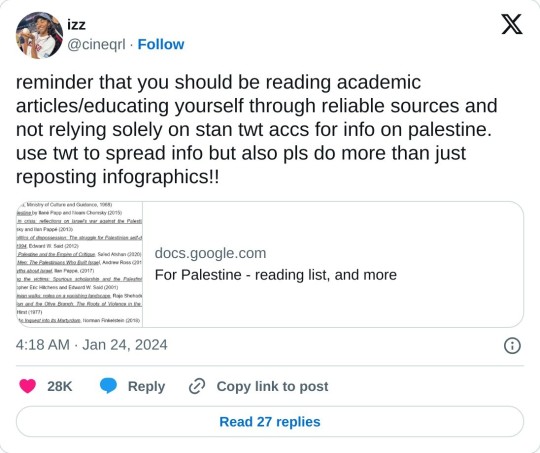
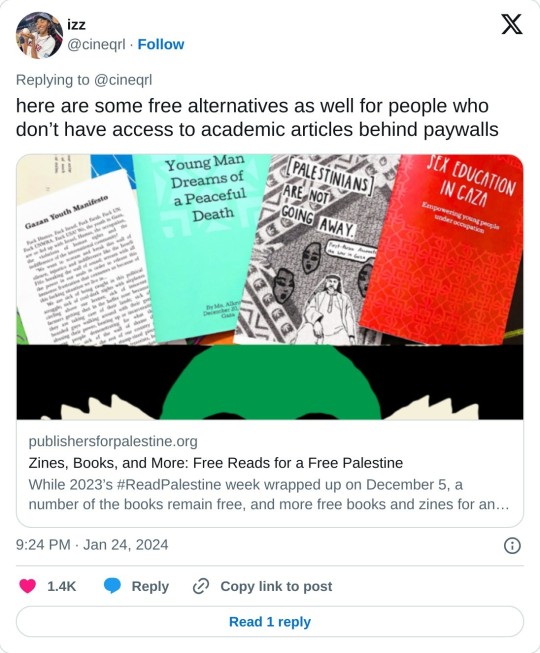
A copy of the first reading list, if you dislike clicking on Google docs links:
The liberal news media is working overtime to silence Palestinian voices. As we sit thousands of miles away, witnessing the massacre through social media, the least we can do is educate ourselves and work to educate others. Apartheid threatens all of us, and just to reiterate, anti-Zionism ≠ antisemitism.
Academic Works, Poetry and Memoirs
The Revolution of 1936-1939 in Palestine: Background, Details, and Analysis, Ghassan Kanafani (1972)
Palestinians: From Peasants to Revolutionaries, Rosemary Sayegh (1979)
Popular Resistance in Palestine: A History of Hope and Empowerment, Mazin Qumsiyeh (2011)
My Life in the PLO: The Inside Story of the Palestinian Struggle, Shafiq al-Hout and Jean Said Makdisi (2019)
My People Shall Live, Leila Khaled (1971)
Poetry of Resistance in Occupied Palestine, translated by Sulafa Hijjawi (Baghdad, Ministry of Culture and Guidance, 1968)
On Palestine by Ilan Pappé and Noam Chomsky (2015)
Gaza in Crisis: Reflections on the US-Israeli War Against the Palestinians, Noam Chomsky and Ilan Pappé (2013)
The Politics of Dispossession: The Struggle for Palestinian Self-Determination, 1969-1994, Edward W. Said (2012)
Queer Palestine and the Empire of Critique, Sa’ed Atshan (2020)
Stone Men: The Palestinians Who Built Israel, Andrew Ross (2019)
Ten Myths About Israel, Ilan Pappé (2017)
Blaming the Victims: Spurious Scholarship and the Palestinian Question, Christopher Eric Hitchens and Edward W. Said (2001)
Palestinian Walks: Notes on a Vanishing Landscape, Raja Shehadeh (2010)
The Gun and the Olive Branch: The Roots of Violence in the Middle East, David Hirst (1977)
Gaza: An Inquest into Its Martyrdom, Norman Finkelstein (2018)
Fateful Triangle: The United States, Israel and the Palestinians, Noam Chomsky (1983)
Israel and Palestine: Reappraisals, Revisions, Refutations, Avi Shlaim (2010)
Politicide: Ariel Sharon’s War Against the Palestinians, Baruch Kimmerling (2006)
The Holocaust Industry: Reflections on the Exploitation of Jewish Suffering, Norman G. Finkelstein (2015)
Light in Gaza: Writings Born of Fire, Jehad Abusalim (2022)
Nakba: Palestine, 1948, and the Claims of Memory, Ahmad H. Sa’di and Lila Abu-Lughod (2007)
Peace and its discontents: Essays on Palestine in the Middle East peace process, Edward W. Said (2012)
Three Poems by Yahya Hassan
Articles, Papers & Essays
“Palestinian history doesn’t start with the Nakba” by PYM (May, 2023)
“What the Uprising Means,” Salim Tamari (1988)
“The Palestinians’ inalienable right to resist,” Louis Allday (2021)
“Liberating a Palestinian Novel from Israeli Prison,” Danya Al-Saleh and Samar Al-Saleh (2023)
Women, War, and Peace: Reflections from the Intifada, Nahla Abdo (2002)
“A Place Without a Door” and “Uncle Give me a Cigarette”—Two Essays by Palestinian Political Prisoner, Walid Daqqah (2023)
“Live Like a Porcupine, Fight Like a Flea,” A Translation of an Article by Basel Al-Araj
Films & Video Essays
Fedayin: Georges Abdallah’s Fight (2021)
Naila and the Uprising (2017)
Off Frame AKA Revolution Until Victory (2015)
Tell Your Tale Little Bird (1993)
The Time That Remains (2009)
“The Present” (short film) (2020)
“How Palestinians were expelled from their homes”
Louis Theroux: The Ultra Zionists (2011)
Born in Gaza (2014)
5 Broken Cameras (2011)
Little Palestine: Diary of a Siege (2021)
Al-Nakba: The Palestinian catastrophe - Episode 1 | Featured Documentary
Organisations to donate to
Palestine Red Crescent Society - https://www.palestinercs.org/en
Anera - https://support.anera.org/a/palestine-emergency
Palestinian American Medical Association - https://palestinian-ama.networkforgood.com/projects/206145-gaza-medical-supplies-oct-2023
You First Gaza - https://donate.gazayoufirst.org/
MAP - Medical Aid for Palestinians - https://www.map.org.uk/donate/donate
United Nations Relief and Works Agency - https://donate.unrwa.org/-landing-page/en_EN
Palestine Children’s Relief Fund - https://www.pcrf.net/
Doctors Without Borders - https://www.doctorswithoutborders.org/what-we-do/where-we-work/palestine
AP Fact Check
https://apnews.com/article/israel-hamas-gaza-misinformation-fact-check-e58f9ab8696309305c3ea2bfb269258e
This list is not exhaustive in any way, and is a summary of various sources on the Internet. Please engage with more ethical, unbiased sources, including Decolonize Palestine and this list compiled by the Palestinian Youth Movement.
390 notes
·
View notes
Text
Why are there Palestinian refugees?
In the months before the British abandoned its mandate & Israel declared independence, civil war raged as Arab factions tried to prevent the Jewish state from being born.
Of course, had the Arabs agreed to the UN's partition plan, they would have had yet another state & there would have been no war in 1948.
But their goal was not another Arab state; it was to ensure there would be no Jewish state.
Meanwhile, 5 #Arab armies amassed on the borders & waited for the British to leave so they could push the Jews into the #Mediterranean Sea.
As Secretary-General of the Arab League Azzam Pasha put it on the day of the Arab #invasion:
"This will be a war of extermination & momentous massacre, which will be spoken of like the Mongolian massacres and the Crusades."
Or as the then war #criminal & fugitive #Nazi Grand Mufti Amin al-Husseini put it during the invasion:
"Murder the #Jews. Murder them all!"
But before the invasion began, & starting as early as Dec 1947, Arab officers began ordering Arab residents of specific villages to flee.
Their reasoning? Arab citizens not involved in active fighting could only: (1) "treacherously" abide the creation of a the Jewish state &/or even become citizens of same; or (2) be in the way of Arab #military deployments & potentially get caught in the crossfire.
And so, for example, on this day (March 8) in 1948, the Arab Higher Committee ordered all Arab women, children & elderly to leave Jerusalem. The order continued, "Any opposition to this order ... is an obstacle to the holy war ... & will hamper the operations of the fighters in these districts.”
In fact, the Arab Higher Committee ordered the evacuation of dozens of Arab villages between April & July of 1948 (see photo of Arab citizens fleeing below).
Meanwhile, on April 19, 1948, Jewish forces secured Tiberias, which had a population of ~6,000 #Arabs - all of whom chose to leave. In fact, they left under British military supervision.
The Jewish Community Council immediately issued a statement regarding Tiberias' Arabs:
"We did not dispossess them; they themselves chose this course ... Let no citizen touch their property."
At around this same time, in early & mid-April of 1948, an Arab faction led by Fawzi al-Qawukji was attacking Haifa & attempting to take the city. Then, rumors spread among Haifa's Arab community that Arab air forces were about to bomb the city & ~25,000 of Haifa's Arabs fled.
As U.S. Consul-General in Haifa Aubrey Lippincott noted on April 22, 1948: "local mufti-dominated Arab leaders ... [urged] all Arabs to leave the city, & large numbers did so."
On April 23, 1948, however, #Jewish forces fought back the Arab attack & retook Haifa.
Three days later, on April 26, 1948, a British police report from Haifa noted:
"[E]very effort is being made by the Jews to persuade the Arab populace to stay and carry on with their normal lives, to get their shops and businesses open and to be assured that their lives and interests will be safe."
What were some of those "efforts?"
Israel's first Prime Minister, David Ben-Gurion, sent future Prime Minister Golda Meir to Haifa with the direct instructions to "persuade the Arabs to stay."
Ms. Meir was unsuccessful, however, as Haifa's Arabs told her they feared that if they stayed, they would be branded "#traitors."
And so, another ~25,000 of Haifa's Arabs fled.
Stop me if you've heard this one before, but despite facts on the ground, Arab leaders at the #UN began demanding the end to a fake "#massacre."
Specifically, #Syria's UN Ambassador Faris al-Kouri, said the Jewish victory at Haifa was a "massacre" that provided "evidence that the '#Zionist program' is to annihilate Arabs within the Jewish state if partition is effected."
The #British were still on the ground, however, & the British Ambassador to the UN, Sir Alexander Cadogan, told the UN the very next day both that the fighting in Haifa had only begun as a result of "continuous attacks by Arabs against Jews" & that the "reports of massacres & deportations [were] erroneous."
Meanwhile, after Israel declared its independence & was invaded by five Arab armies, the newly established #IDF issued an Order on July 6, 1948, making it clear that non-combatant Arab civilians were not to be harassed or expelled, nor their villages touched.
But the Arabs were being given a very different message.
#Iraqi #PrimeMinister Nuri Said announced:
"We will smash the country with our guns & obliterate every place the Jews seek shelter in. The Arabs should conduct their wives & children to safe areas until the fighting has died down."
This used to be known. In fact, Arab leaders for years after the war had no qualms about repeating it.
For example, Syrian Prime Minister Haled al Azm later wrote:
"Since 1948, we have been demanding the return of the #refugees to their homes. But we ourselves are the ones who encouraged them to leave. Only a few months separated our call to them to leave & our appeal to the UN to resolve on their return."
Similarly, #Jordan's King Abdullah wrote:
"The tragedy of the #Palestinians was that most of their leaders had paralyzed them with false & unsubstantiated promises that they were not alone; that 80 million Arabs & 400 million #Muslims would instantly & miraculously come to their rescue."
Similarly, Edward Atiyah, Secretary of the Arab League Office in #London wrote:
"This wholesale #exodus was due partly to the belief of the Arabs, encouraged by the boastings of an unrealistic #Arabic press & the irresponsible utterances of some of the Arab leaders that it could be only a matter of weeks before the Jews were defeated by the armies of the Arab States & the #Palestinian Arabs enabled to reenter & retake possession of their country.”
Even as the war still raged on Aug 16, 1948, the Arab #Greek Orthodox Catholic Bishop of the Galilee told #Beirut newspaper Sada al-Janub:
“The refugees were confident their absence would not last long, & that they would return within a week or two ... Their leaders had promised them that the Arab Armies would crush the ’Zionist gangs’ very quickly & that there was no need for panic or fear of a long exile.”
A few months later, on Feb 19, 1949, the Jordanian newspaper Filastin confirmed:
"The Arab States encouraged the Palestine Arabs to leave their homes temporarily in order to be out of the way of the Arab invasion armies."
Even many of the Palestinian Arab refugees themselves admitted their reasons for leaving.
For example, on June 8, 1951, Habib Issa admitted to #NewYork Lebanese newspaper Al Hoda:
"Azzam Pasha assured the Arab peoples that the #occupation of Palestine & #TelAviv would be ... simple ... He pointed out that they were already on the frontiers & that all the millions the Jews had spent on land & economic development would be easy booty, for it would be a simple matter to throw Jews into the Mediterranean ... Arabs of Palestine [were told] to leave their land, homes & property & to stay temporarily in neighboring fraternal states, lest the guns of the invading Arab armies mow them down.”
Similarly, Asmaa Jabir Balasimah recalled being told by Arab leaders to "evacuate the village & return after the battle is over," & that she & others in her village left all their possessions behind "based on the assumption that we would return after a few hours."
Again, however (& most importantly), had the Arabs agreed to Partition or even agreed to negotiate different borders with Zionist leaders who begged Azzam Pasha to make any counteroffer instead of invading with #genocidal intent, there would never have been a single Palestinian #refugee.

283 notes
·
View notes